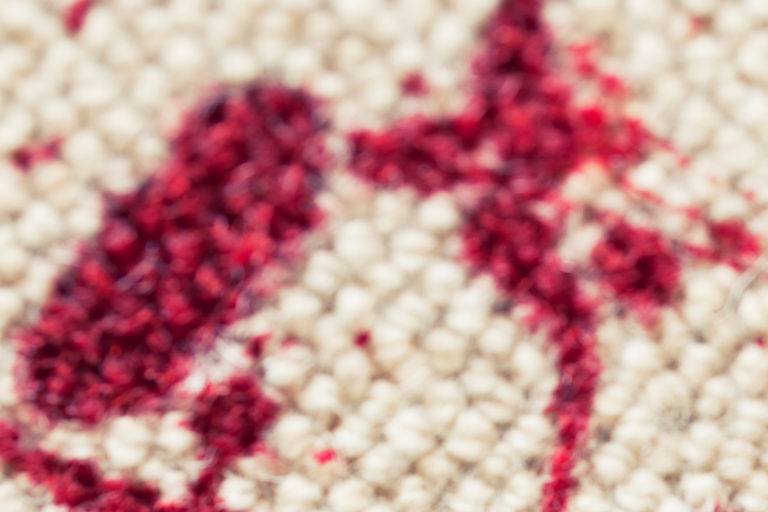
Quick Tips
Bloodstains have a nasty habit of setting faster than your sense of panic when you realize they won’t budge. Whether it’s from a minor injury, a nosebleed, or an unfortunate kitchen mishap, knowing how to clean blood properly can save your fabrics, carpets, and hard surfaces from permanent damage. The key? Acting fast and using the right cleaning solutions. Follow these seven steps to ensure your crime-scene-worthy stain disappears without a trace.
Essential Supplies You’ll Need
- Cold Water – Hot water sets bloodstains, so avoid it at all costs.
- Hydrogen Peroxide (3%) – An effective blood remover for non-delicate fabrics.
- Liquid Dish Soap – Breaks down proteins in blood for easier removal.
- Baking Soda or Salt – Helps lift stains from fabric and carpet.
- Ammonia (Optional) – For extra-stubborn stains on hard surfaces.
- Clean White Cloths or Paper Towels – For blotting and scrubbing.
- Soft Brush or Sponge – To help lift blood from surfaces.
Step-by-Step: How to Clean Blood Stains
1. Act Fast—Time Is Your Enemy
The sooner you address a bloodstain, the better your chances of completely removing it. If the stain is fresh, blot (don’t rub!) with a clean cloth soaked in cold water. Rubbing spreads the stain and forces it deeper into the material.
2. Use Cold Water and Blot Repeatedly
For fabric and upholstery, soak the stain in cold water for at least 10-15 minutes. If possible, hold the fabric under running water, directing the flow from the back of the stain to push the blood out rather than deeper in.
3. Apply Hydrogen Peroxide for Tough Stains
If cold water alone isn’t cutting it, pour hydrogen peroxide (3%) directly onto the stain. Let it bubble for a few minutes, then blot with a clean cloth. Peroxide is great for white fabrics but can bleach colored fabrics, so do a spot test first.
4. Make a Baking Soda or Salt Paste
For dried blood stains, mix baking soda or salt with a little cold water to create a paste. Apply it to the stain, let it sit for 30 minutes, then gently scrub with a soft brush before rinsing.
5. Use Dish Soap for Delicate Fabrics
If you’re working with silk, wool, or other delicate fabrics, avoid peroxide and instead apply a drop of dish soap mixed with cold water. Blot gently and rinse thoroughly.
6. Tackle Carpets and Mattresses with Patience
For carpets and mattresses, blot with cold water and dish soap, then sprinkle baking soda over the damp stain. Let it sit until dry, then vacuum the residue. Repeat if necessary. If you’re dealing with a particularly persistent stain, our guide on How to Clean a Carpet Stain offers additional techniques.
7. Disinfect Hard Surfaces
For blood on tile, countertops, or wood floors, wipe with hydrogen peroxide or a diluted ammonia solution (1 part ammonia to 10 parts water). Always test a small area first to prevent damage. Rinse well and dry the area completely.
How Professionals Clean Blood Stains
When professionals tackle bloodstains—especially in forensic cleanup or medical settings—they follow strict protocols. According to experts like the American Cleaning Institute, professional cleaners use:
- Enzyme-Based Cleaners – These break down proteins in blood more effectively than standard detergents.
- Steam Cleaning for Carpets and Upholstery – Professionals use high-temperature steam to loosen and lift dried blood.
- Oxidizing Agents for Stubborn Stains – Similar to hydrogen peroxide but at an industrial strength.
- Protective Gear – Gloves and masks ensure safe handling of biohazardous stains.
- Specialized Disposal Methods – For significant spills, pros follow OSHA and CDC guidelines on biohazard cleanup.
For household bloodstain removal, using enzyme cleaners and thorough cold water treatments can help achieve professional-level results.
Pro Tips for Preventing Set-In Stains
- Never Use Hot Water – It cooks the proteins in blood, making the stain permanent.
- Always Blot, Never Rub – Rubbing forces blood deeper into fibers.
- Test Cleaning Solutions First – Especially on colored fabrics or delicate surfaces.
- Repeat the Process if Necessary – Some stains require multiple treatments.
- Store Hydrogen Peroxide in a Dark Bottle – Light exposure weakens its effectiveness over time.
Final Thoughts
Bloodstains might be intimidating, but they don’t have to be permanent. With the right approach—and a little urgency—you can remove every trace before it becomes a lasting reminder. Whether it’s on clothes, carpets, or hard surfaces, these seven foolproof steps will help you restore your fabrics and furniture to their former (stain-free) glory.